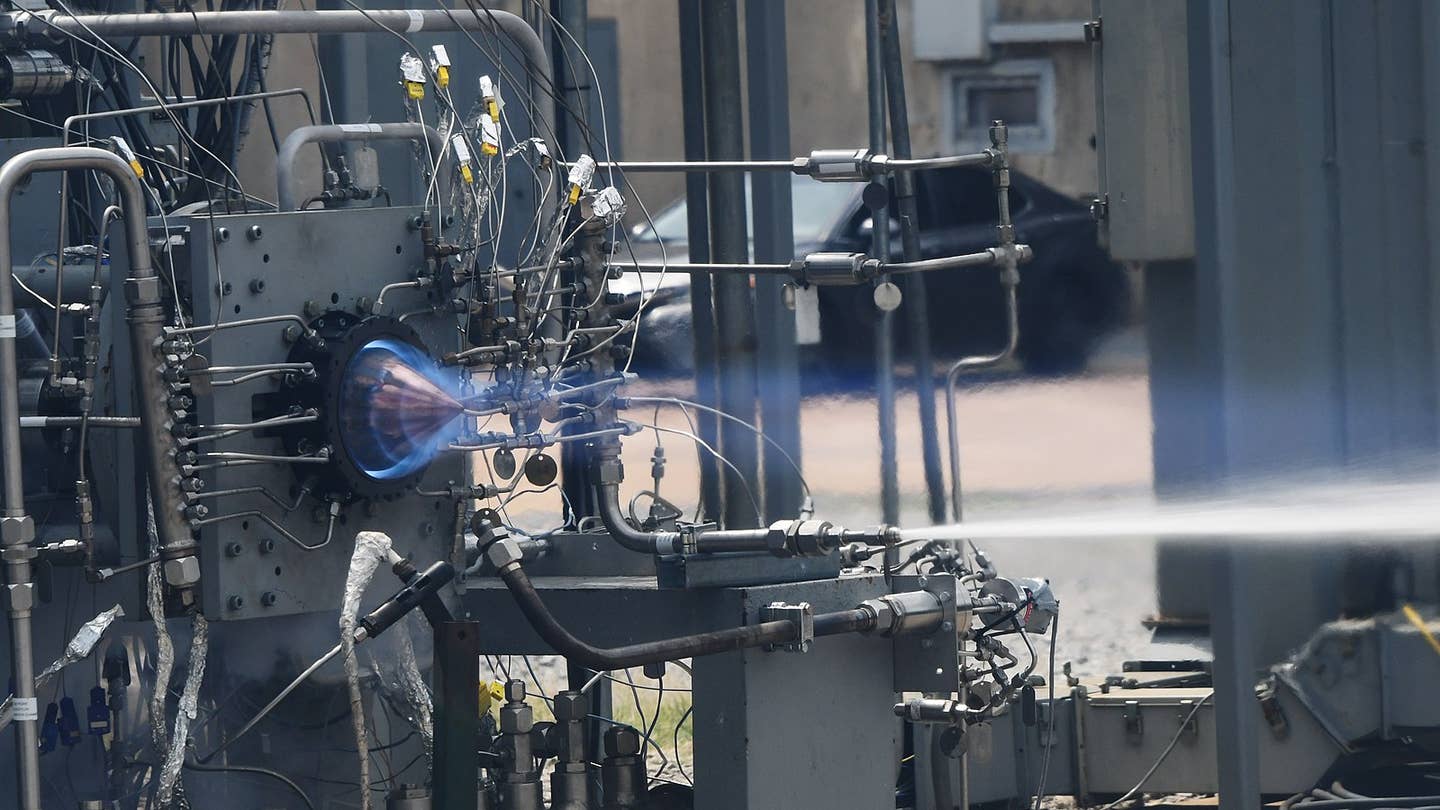These fancy new rotating detonation engines explode constantly by design

A prototype RDE under test at the Marshall Space Flight Center
SUMMARY
They're noisy, but your next missile or military vehicle might have an RDE (rotating detonation engine) powerplant in it. RDEs are more fuel-efficient, lighter, easier to maintain, and capable of higher speeds than traditional combustion engines. And the Navy, NASA, DARPA, and a bunch of defense contractors bet big that they can stuff them in everything from a ship to a cruise missile to spacecraft.
What are rotating detonation engines used for?
The difference between combustion and explosion comes down to speed. And skip the next two paragraphs if you hate numbers, because your author went and read some encyclopedias and scientific papers to prep for this next part.
A combustion reaction takes place when chemicals burn and release energy. In a typical fossil-fuel engine, the reaction moves through the chemicals at 0.5 meters per second. That's deflagration speeds. That's...actually not that fast. A 19-year-old male has to run over five times that speed to pass the ACFT. But an explosive reaction in a gas starts at 2 kilometers per second. Run that fast, and you'd finish a 2-mile in under 2 seconds. Thank you for your service, Pietro.
Even jet engines have to drastically slow down the air coming into them to deal with the low speed of a combustion reaction. At its slowest point, right before combustion, the velocity of air in many jet engines is just 3 meters or so per second, almost 7 mph. So the jet is flying faster than the speed of sound, but it has to slow the air flowing into it to the speed of an above-average marathoner.
And that slow-moving reaction also allows some of the fuel to escape the reaction. Fuel at the edges of the initial reaction can be pushed away from the action long enough to never reach oxygen and heat at the same time, resulting in it passing through the engine unused.
But with a rotating detonation engine, the reaction is a literal explosion. And the engine strings thousands of explosions together to create constant thrust. Because the reaction moves so fast, more of the fuel is burnt, granting greater efficiency.

Types of RDEs
As hinted above, there are two major types of RDEs.
In both, a set of two cylinders forms the heart of the system. A smaller cylinder sits inside of a larger one with a small gap between the two. The gap is the combustion area. Fuel enters at the front end of the larger cylinder and flows through the gap until it is exploded. The resulting shockwave and pressurized air exit the back of the cylinder at great speeds. The explosion constantly propagates around the inner cylinder, rotating around it, hence RDE. The explosion forms a rotating detonation wave or, in industry parlance, RDW.
Rotating Detonation Rocket Engine
In a rotating detonation rocket engine, or RDRE, that gas exiting the back is harnessed as thrust that propels the aircraft forward. Bam, you're done.
Gas Turbine
In a gas turbine RDE, a turbine is simply added to the back. The high-speed gas turns the turbine, turbine spins a generator, and electricity is created.
The U.S. government, a few contractors, and more have all created both types, mostly using hydrogen as the fuel. And China at least claims to have created an RDRE that uses aviation kerosene similar to American JP-8 and can propel an aircraft at Mach 9.
If you had a big pile of successful RDRE engines, you could literally just plug them into anywhere we use a gas turbine engine or jet engine and get greater efficiency and performance for less weight, less space, and less maintenance. Smaller, lighter tanks. Ships with much greater range. Jets that take just a few hours to maintain and put back in the air. Lighter missiles that are cheaper and carry larger payloads. It's the promised land.
Limitations of RDEs
So why don't we live in the future? Well, believe it or not, controlling explosive combustions traveling through nested cylinders with no moving parts as gases and reactions move at over 1 mile per second gets complicated.
Weird, right?
Without getting too deep in the weeds, different chemicals flow through the cylinders at different rates. And the rotating detonation wave moves through them at different rates. Worse, different parts of a chemical can flow at such different rates that a complex fuel can separate as it flows, resulting in some parts not combusting or the RDW moving at different rates through the cylinders.
And then, some molecules may make it too far down the cylinder before they explode and then send a shockwave that pushes backward, disrupting the flow of gases.
Basically, engineers have to perfectly tune RDEs to get them to work properly, whether they're in a rocket or on a turbine.
Engineers are making progress. While RDEs would be game changers for military missiles and aircraft and beneficial for turbine-powered vehicles like ships and Abrams tanks, they would also be a huge boon to the civilian economy.
Imagine every ship and plane becoming more efficient over the next decade, dropping competition for fuel. Suddenly, the geopolitics around Russia, Saudi Arabia, China, and more become easier. And every space launch could require less fuel, reducing weight and cost of launch exponentially.
And NASA, DARPA, and more are working hard to make it happen.
SHARE
